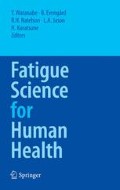Abstract
Recently, we established an animal model of combined (mental and physical) fatigue. To make this model, we kept rats for 5 days in a cage filled with water (23 ± 1°C) to a height of 1.5 cm, and for an evaluation of the extent of fatigue, a weight-loaded forced swimming test was used. The fatigued animals showed reduced brain energy utilization as compared with the controls. Although acutely stressed rats showed increased turnover of serotonin and dopamine in the brain, the fatigued rats did not show any change in the levels of these neurotransmitters and the metabolites in the brain regions in which the synaptic terminals are abundant. Hence, decreased energy utilization induced by prolonged deprivation of rest may introduce a vicious cycle of fatigue and lead to insufficient activation of the serotonin and dopamine systems in the brain. Since the serotonin and dopamine systems are not activated properly under the condition of fatigue, the fatigue sensation and physical activity may become insufficient, and in the terminal stage, long-term deprivation of rest may lead to death (Karoshi). We also found that by using this animal model of fatigue, we could screen for candidates for antifatigue substances for human use.
Access this chapter
Tax calculation will be finalised at checkout
Purchases are for personal use only
Preview
Unable to display preview. Download preview PDF.
References
Tanaka M, Nakamura F, Mizokawa S, Matsumura A, Nozaki S, Watanabe Y (2003) Establishment and assessment of a rat model of fatigue. Neurosci Lett 352:159–162
Moriura T, Matsuda H, Kubo M (1996) Pharmacological study on Agkistrodon blomhoffii blomhoffii BOIE. V. anti-fatigue effect of the 50% ethanol extract in acute weight-loaded forced swimming-treated rats. Biol Pharm Bull 19:62–66
Heuser JE, Reese TS (1973) Evidence for recycling of synaptic vesicle membrane during transmitter release at the frog neuromuscular junction. J Cell Biol 57:315–344
Atwood HL, Lang F, Morin WA (1972) Synaptic vesicles: selective depletion in crayfish excitatory and inhibitory axons. Science 176:1353–1355
Nguyen PV, Marin L, Atwood HL (1997) Synaptic physiology and mitochondrial function in crayfish tonic and phasic motor neurons. J Neurophysiol 78:281–294
Llinas R, Sugimori M, Lin JWL, Leopold PL, Brady ST (1989) ATP-dependent directional movement of rat synaptic vesicles injected into the presynaptic terminal of squid giant synapse. Proc Natl Acad Sci USA 86:5656–5660
Tanaka M, Watanabe Y (2008) Reduced energy utilization in the brain is a feature of an animal model of fatigue. Int J Neurosci (in press)
Nakahara H, Kanno T, Inai Y, Utsumi K, Hiramatsu M, Mori A, Packer L (1998) Mitochondrial dysfunction in the senescence-accelerated mouse (SAM). Free Radic Biol Med 24:85–92
Sibille B, Ronot X, Filippi C, Nogueira V, Keriel C, Leverve X (1988) 2,4-dinitrophenol uncoupling effect on delta psi in living hepatocytes depends on reducing equivalent supply. Cytometry 32:102–108
Meeusen R, De-Meirleir K (1995) Exercise and brain neurotransmission. Sports Med 20:160–188
Bailey SP, Davis JM (1993) Serotonergic agonists and antagonists affect endurance performance in the rat. Int J Sports Med 14:330–333
Bhagat B, Wheeler N (1973) Effect of amphetamine on the swimming endurance of rats. Neuropharmacology 12:711–713
Heyes MP, Garnett ES, Coates G (1988) Nigrostriatal dopaminergic activity is increased during exhaustive exercise stress in rats. Life Sci 42:1537–1542
Davis LM, Bailey SP (1997) Possible mechanisms of central nervous system fatigue during exercise. Med Sci Sports Exerc 29:45–57
Giraldez L, Diaz-Hernandez M, Gomez-Villafuertes R, Pintor J, Castro E, Miras-Portugal MT (2001) Adenosine triphosphate and diadenosine pentaphosphate induce [Ca(2+)](i) increase in rat basal ganglia aminergic terminals. J Neurosci Res 64:174–182
Inoue K, Yamazaki H, Manabe Y, Fukuda C, Hanai K, Fushiki T (1999) Transforming growth factor-beta activated during exercise in brain depresses spontaneous motor activity of animals. Relevance to central fatigue. Brain Res 846:145–153
Liu J, Wang X, Shigenaga MK, Yeo HC, Mori A, Ames BN (1996) Immobilization stress causes oxidative damage to lipid, protein, and DNA in the brain of rats. FASEB J 10:1532–1538
Kodama M, Kodama T, Murakami M (1996) The value of the dehydroepiandrosteroneannexed vitamin C infusion treatment in the clinical control of chronic fatigue syndrome (CFS). II. Characterization of CFS patients with special reference to their response to a new vitamin C infusion treatment. In Vivo 10:585–596
Kodama M, Kodama T, Murakami M (1996) The value of the dehydroepiandrosteroneannexed vitamin C infusion treatment in the clinical control of chronic fatigue syndrome (CFS). I. A pilot study of the new vitamin C infusion treatment with a volunteer CFS patient. In Vivo 10:575–584
Cleare AJ, O’Keane V, Miell JP (2004) Levels of DHEA and DHEAS and responses to CRH stimulation and hydrocortisone treatment in chronic fatigue syndrome. Psychoneuroendocrinology 29:724–732
Scott LV, Salahuddin F, Cooney J, Svec F, Dinan TG (1999) Differences in adrenal steroid profile in chronic fatigue syndrome, in depression and in health. J Affect Disord 54:129–137
Kuratsune H, Yamaguti K, Sawada M, Kodate S, Machii T, Kanakura Y, Kitani T (1998) Dehydroepiandrosterone sulfate deficiency in chronic fatigue syndrome. Int J Mol Med 1:143–146
Vermeulen RC, Scholte HR (2004) Exploratory open label, randomized study of acetyl-and propionylcarnitine in chronic fatigue syndrome. Psychosom Med 66:276–282
Author information
Authors and Affiliations
Editor information
Editors and Affiliations
Rights and permissions
Copyright information
© 2008 Springer
About this chapter
Cite this chapter
Tanaka, M., Watanabe, Y. (2008). Mechanism of Fatigue Studied in a Newly Developed Animal Model of Combined (Mental and Physical) Fatigue. In: Watanabe, Y., Evengård, B., Natelson, B.H., Jason, L.A., Kuratsune, H. (eds) Fatigue Science for Human Health. Springer, Tokyo. https://doi.org/10.1007/978-4-431-73464-2_15
Download citation
DOI: https://doi.org/10.1007/978-4-431-73464-2_15
Publisher Name: Springer, Tokyo
Print ISBN: 978-4-431-73463-5
Online ISBN: 978-4-431-73464-2
eBook Packages: MedicineMedicine (R0)

